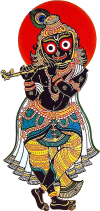Glossary

A
- Ananta: A Sanskrit word that means infinite or endless.
- Aruna Stambh: A tower at the entrance of the Jagannath temple in Puri, India.
- Avatar: A deity’s physical appearance or incarnation on earth.
B
- Bhagavad Gita: A Sanatan Dharma scripture that contains a dialogue between Lord Krishna and Arjuna.
- Bhajan: A devotional song typically sung in praise of deities.
- Bhagwat/Bhagavata/Bhagvat: A Sanatan Dharma scripture that describes the life and teachings of Lord Krishna.
- Brahmand: The universe in Sanatan Dharma cosmology.
- Bhakti: It is a Sanskrit term that refers to devotion, love, or affection towards the Supreme Lord Mahavishnu. It is considered to be one of the paths to moksha or liberation and involves surrendering oneself to the divine and cultivating a relationship of love and devotion with the chosen deity or guru through prayer, worship, and other devotional practices.
C
- Chakra: A circular weapon associated with Lord Vishnu and used for spiritual purposes.
D
- Dashavatar: The ten incarnations of Lord Vishnu in Sanatan Dharma.
- Daya: Compassion or kindness.
- Devi: The feminine divine or goddess.
- Devta: A Sanatan Dharma deity.
- Digpalas: The guardians of the directions in Sanatan Dharma.
- Dharma: The universal principles that guide ethical and moral behavior in Sanatan Dharma.
- Dharma Sansthapana: Establishing righteousness or dharma.
- Dwapara Yuga: The third of four ages or yugas in Sanatan Dharma cosmology.
G
- Garuda: A mythical bird and mount of Lord Vishnu.
- Gada: A mace or weapon associated with Lord Hanuman in Sanatan Dharma.
- Golok Dham: The highest spiritual abode in Sanatan Dharma, where Lord Krishna resides.
J
- Jagat: The world or universe.
- Jai: A term used to express victory or success.
- Janani: Mother.
K
- Kalpavata: A wish-fulfilling tree in Sanatan Dharma mythology which is situated inside the premises of Shree Jagannath Temple, Puri.
- Kali/Kali Yuga: The fourth and final of four ages or yugas in Sanatan Dharma cosmology which is the age of hypocrisy and quarrel.
- Kalkidev: Another name by which Lord Kalki is addressed.
- Kalkiram: The name by which Lord Kalki will be known after ‘Dharma Sansthapana’.
- Khanda Pralay: A cosmic partial destruction in Sanatan Dharma.
- Kirtan: A devotional song or chant.
- Kshama: Forgiveness.
- Kshetra: A sacred place or land or region.
- Koti: Ten million or used to refer to countless.
M
- Mahamantra: A powerful mantra or chant. The most powerful mantra during the present time is the Kalki Mahamantra.
- Mahapurush: A great person or sage.
- Mahaprasad: A sacred food offering to Lord Jagannath.
- Maharaja: A great king or ruler.
- Mahatmya: The greatness or significance of a sacred place, deity or scripture.
- Mahavishnu: The name of Lord Vishnu in Sanatan Dharma.
- Maitri: Friendship or camaraderie.
- Mandal: A group.
- Mata: Mother.
- Mleccha: A person who does not follow righteous conduct.
N
- Nakshatra: A lunar mansion or constellation.
- Naam: The divine name of a deity.
- Nath: A lord or master.
- Nila Chakra or Neela Chakra: A disc-shaped ornament on top of the Jagannath temple in Puri, India.
- Nilachal or Neelachal: Another name for the Jagannath temple in Puri, India.
- Nirmalya: Refers to the leftover flowers, fruits, and other offerings that are removed from the deity of Lord Jagannath after worship in Puri Jagannath temple.
P
- Panch Bhoota: The five elements – earth, water, fire, air, and space – in Sanatan Dharma.
- Panchasakha: The five companions of Lord Jagannath in Odisha, India who have inscribed the texts of ‘Bhavishya Malika.’
- Padma: A lotus flower, often associated with deities.
- Param Brahm: The supreme divine being in Sanatan Dharma.
- Puran: A genre of Sanatan Dharma scripture that tells ancient stories and legends.
- Purushottam: An epithet of Lord Vishnu meaning “supreme being.”
R
- Ratna Singhasan: A throne made of precious gems or jewels.
S
- Samudra Manthan: A mythological tale in Sanatan Dharma about the churning of the ocean to obtain the nectar of immortality.
- Samvad: A Sanskrit term for dialogue or conversation.
- Sanatan Dharma: The original and real name for Hinduism, which means the eternal or timeless religion.
- Sankha: A conch shell used in Hindu rituals and ceremonies.
- Sankirtan: A form of devotional singing and chanting in Sanatan Dharma.
- Satya: A Sanskrit term for truth or reality.
- Satya Ananta Madhaba: Lord Jagannath, worshipped in the Jagannath Temple in Puri, India has incarnated at the end of Kali Yuga in Odisha, India as Lord Kalki and will be known as ‘Satya Ananta Madhaba’ among His devotees.
- Satya Yuga: The first of the four yugas or cosmic ages in Sanatan Dharma, also known as the golden age.
- Sevak: A person who serves or worships a deity or guru.
- Shanti: A Sanskrit term for peace or tranquility.
- Shastra: A Sanskrit term for a text, treatise, or scripture.
- Shree Jagannath Kshetra: The holy town of Puri in Odisha, India, where the Jagannath Temple is located.
- Shreemad Bhagwat or Shrimad/Shreemad Bhagavatam Mahapuran: It is one of the 18 major Puranas in Sanatan Dharma, authored by Ved Vyasa, that narrates the life and teachings of Lord Krishna and emphasizes the path of devotion (bhakti) as the means of attaining liberation.
- Stotra: A hymn or devotional song in praise of a deity or guru.
- Subha Stambh: A pillar or column erected as a symbol of victory or achievement located in Jajpur, Odisha, India.
T
- Treta Yuga: The second of the four yugas or cosmic ages in Sanatan Dharma.
- Tri-Sandhya: A daily ritual in Sanatan Dharma that involves reciting prayers and mantras during three periods of the day: dawn, midday, and dusk.
- Tulsi: Tulsi, also known as Holy Basil, is a sacred plant in Sanatan Dharma that is revered for its medicinal and spiritual properties. It is considered to be an incarnation of the goddess Tulsi and is often planted near temples and homes. In Sanatan Dharma, Tulsi leaves are offered to the deities and are considered to be purifying and auspicious.
U
- Upavas: A Sanskrit term for fasting or abstaining from food for spiritual or religious reasons. But as per teachings of Lord Kalki real ‘Upavas’ refers to staying near God rather than fasting or abstinence from food. It advocates the regular practice of being God-conscious and always seeking His divine presence.
V
- Vanaparv: A section of the Sanatan Dharma epic Mahabharata that describes the forest life of the Pandavas during their exile.
- Varun Devta: A Sanatan Dharma deity associated with the oceans, rivers, and water bodies.
- Veda: A collection of ancient Hindu scriptures that are considered to be the oldest and most sacred texts in Sanatan Dharma.
- Vishwa: A Sanskrit term for the universe or the world.
Y
- Yagnyas or Yajna: A Hindu ritual that involves offerings made to a sacred fire, usually for a specific purpose or intention.

